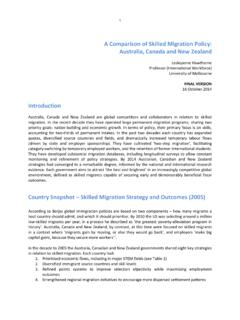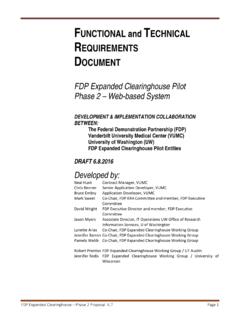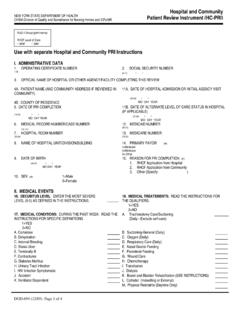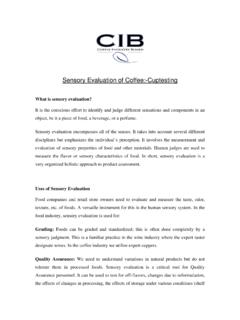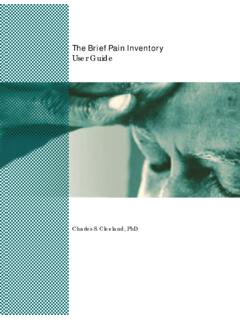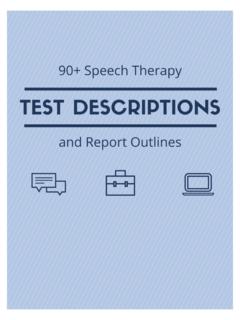Transcription of Measurement of Attitudes, Beliefs and Behaviors of Mental ...
1 1 Opinions and statements included in this paper are solely those of the individual author(s), and are not necessarily adopted or endorsed or verified as accurate by the Board on Behavioral, Cognitive, and sensory Sciences or the National Academy of Sciences, Engineering and Medicine Measurement of Attitudes, Beliefs and Behaviors of Mental health and Mental Illness Lawrence H. Yang Columbia University Bruce G. Link University of California at Riverside October 2015 We thank Francesca Crump, Junko Morita, Bernalyn Ruiz, and Jenny Shen for help in the literature review and formatting the manuscript.
2 2 Opinions and statements included in this paper are solely those of the individual author(s), and are not necessarily adopted or endorsed or verified as accurate by the Board on Behavioral, Cognitive, and sensory Sciences or the National Academy of Sciences, Engineering and Medicine Overview: Accurate Measurement of Mental illness stigma will rest on our ability to conceptualize stigma processes, the factors that produce and sustain such processes, and the mechanisms that lead to stigma outcomes. To better observe and measure the essential components of stigma, this paper is designed to assist researchers in selecting or creating measures that can address critical research questions regarding stigma.
3 Our conceptualization of stigma processes leads us to consider components of labeling, stereotyping, setting apart, emotional responses, status loss and discrimination. We provide a narrative review of measures of Mental illness stigma and profile the status of current stigma Measurement . We identify commonly used measures so that readers can make decisions as to whether the described measure might be appropriate for their study. We end by identifying promising Measurement strategies that advance important areas in stigma Measurement . Introduction If we are to systematically reduce stigma and improve Mental health and Mental health care, we must have the capacity to observe and measure stigma.
4 The central purpose of this paper is to assist researchers interested in the stigma of Mental illness to accurately select and create empirically-based measures of stigma. We also identify new advances in stigma Measurement that address gaps that need further attention. We examine the measures identified by recent systematic reviews of the stigma Measurement literature (Livingston & Boyd, 2010; Brohan, Slade, Clement, & Thornicroft, 2010; Stevelink, Wu, Voorend, Brakel, 2012), which in total reviewed 217 articles focused on the stigma of Mental illness that were published between 1900 and 2011. Also we utilized focal measures assessing attitudes of healthcare providers, which comprise the Attitude to Mental Illness Questionnaire (AMIQ) and The Psychiatric Disability Attribution Questionnaire (PDAQ) (Van Boekel, Brouwers, Weeghel, & Garretsen, 2013).
5 We review the breadth of Measurement approaches used in studying stigma, the study populations that these measures have been used with, and the range of stigma concepts covered. We also present brief summaries of commonly used stigma measures via detailed tables. In the Tables we describe the stigma domains measured, provide sample items, review reliability and validity, indicate whether the measure has been utilized with a commonly used vignette design, identify strengths and weaknesses, and provide citations. Following these tables we address four advances in the Measurement of stigma that simultaneously indicate a need for further development: 1) distinguishing stigma of the label vs.
6 Stigma of the Mental illness symptom and experience ; 2) implicit attitudes of stigma, 3) assessment of structural discrimination related to Mental illness and 4) assessment of culture-specific aspects of stigma. Conceptualization of Stigma Dating from Goffman (1963) and before (Schwartz et al. and Cumming and Cumming), 3 Opinions and statements included in this paper are solely those of the individual author(s), and are not necessarily adopted or endorsed or verified as accurate by the Board on Behavioral, Cognitive, and sensory Sciences or the National Academy of Sciences, Engineering and Medicine multiple conceptualizations of stigma have been put forward.
7 While differences exist, a common core can be identified. One way to think about how they differ but still fill out the stigma concept is to identify whether they seek to describe what stigma is (Goffman 1963; Link and Phelan 2001), how stigmatizing circumstances differ one from the other (Goffman 1963, Jones et al 1984), where stigma comes from (Phelan et al. 2008) or how does stigma vary across cultures (Yang et al. 2007). For reviews of stigma conceptualizations see (Link et al. 2004; Pescosolido 2015). Stigma Measurement Approaches We base our review on systematic literature searches of terms synonymous with stigma and Mental disorders (Livingston & Boyd, 2010; Brohan, Slade, Clement, & Thornicroft, 2010; Stevelink, Wu, Voorend, Brakel, 2012).
8 While this review is not exhaustive; it represents a broad assessment of current stigma measures in use. General Community Attitude Measures Social Distance One of the most commonly used approaches, social distance, assesses a respondent s willingness to interact with a target person in different types of relationships. Scale items differ in the closeness of the association a respondent is asked to endorse or decline. This concept has the longest tradition, stemming from the first social distance scale (Bogardus 1925) which was used to describe social distance by race/ethnicity, followed by the assessment of Mental illnesses in Cumming and Cumming s (1957) study.
9 Vignettes have been frequently used in tandem with social distance scales, starting since Phillips (1963) and continuing to modern-day nationally-representative attitude surveys (Pescosolido et al, 2013). Another example is the RIBS ( Reported and Intended Behavior Scale ) which has been used in the national UK Time to Change anti-stigma campaign that evaluates intended behavior towards living with, working with, working nearby, and continuing a relationship with someone with a Mental illness (Evans-Lacko, .. & Thornicroft, 2011). Good to excellent internal-consistency reliability and construct validity have been reported for these scales.
10 However, limitations include 1) social-desirability bias motivated by a desire not to want to appear heartless or ignorant and 2) the fact that the items assess behavioral intentions rather than Behaviors . Semantic Differential and Related Measures Developed by Charles E. Osgood and colleagues (1957), the Semantic Differential is a Measurement technique that provides a direct assessment of stereotyping, or the tendency to link a label like person with Mental illness with negative attributes. The Semantic Differential presents respondents with labels, or concepts, such as person with Mental illness and asks them to evaluate the extent to which those labels are associated with various characteristics, 4 Opinions and statements included in this paper are solely those of the individual author(s), and are not necessarily adopted or endorsed or verified as accurate by the Board on Behavioral, Cognitive, and sensory Sciences or the National Academy of Sciences, Engineering and Medicine each bounded by a pair of polar adjectives ( , dangerous safe ).





